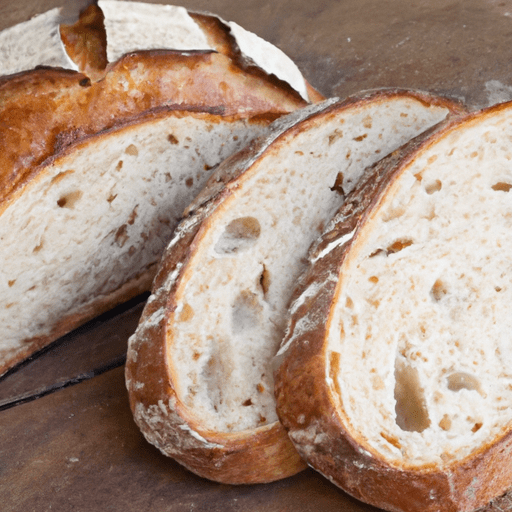The Magic of Sourdough Bread: A Culinary Journey
If you’ve ever experienced the distinct tangy flavor and tantalizing aroma of sourdough bread, you know there’s something magical about it. The combination of simplicity and complexity in this age-old bread has made it a staple in many cuisines around the world. Let’s dive into the delightful world of sourdough bread and uncover its taste, common uses, nutritional value, and intriguing history.
A Taste That Packs a Punch
Sourdough bread boasts a unique flavor profile that sets it apart from other bread varieties. The characteristic tanginess, a result of the lactobacillus bacteria in the starter culture, is what gives this bread its distinct taste. The longer fermentation process involved in crafting sourdough bread enhances the complexity of flavors, resulting in a rich, slightly acidic, and earthy taste. Bite into a slice, and you’ll experience a delightful blend of nuttiness and subtle sweetness, complemented by a chewy, yet tender, texture.
Versatility in the Kitchen
Not just a mere loaf of bread, sourdough is a versatile culinary asset with numerous uses in the kitchen. From toasties to tartines and sandwiches to stuffing, this bread can elevate any dish to new heights. The tangy flavor pairs exceptionally well with both savory and sweet accompaniments, making it a favorite for creative chefs and home cooks.
For a heavenly breakfast treat, slather a warm slice of sourdough with butter and homemade preserves. The contrasting flavors dance on your palate, creating a symphony of tastes. If you’re looking for a savory option, top grilled sourdough with fresh tomatoes, creamy mozzarella, and a drizzle of balsamic glaze for a mouthwatering bruschetta.
Nutritional Powerhouse
While sourdough bread pleases the senses, it also offers several nutritional benefits. This bread stands out by often being easier to digest compared to traditional bread. The fermentation process not only imparts flavor but also breaks down complex carbohydrates and gluten proteins, potentially making it more tolerable for those with sensitivity. Additionally, sourdough bread has a lower glycemic index, meaning it causes a slower and steadier rise in blood sugar levels compared to bread made with commercial yeast.
Furthermore, sourdough bread contains essential nutrients such as B vitamins, iron, and selenium, which are vital for energy production, brain function, and immune health. With a high water content and natural acidity, this bread also boasts excellent keeping qualities, staying fresh for longer periods without the need for preservatives.
Discovering the Origins
Delving into the captivating history of sourdough, we find ourselves transported back centuries ago. Bread made with wild yeast and lactobacillus cultures can be traced back to ancient Egypt. However, it was the French, particularly in the region of San Francisco, who perfected the art of sourdough bread during the California Gold Rush in the mid-1800s. The unique flavor of San Francisco sourdough stems from a particular strain of lactobacillus found in the indigenous yeasts of the region.
A Fun Fact: Sourdough Starter Legacy
Perhaps one of the most fascinating aspects of sourdough bread is the sourdough starter culture. It is a living organism, a mixture of flour and water kept alive over generations of bakers. Many bakers pass down their precious sourdough starter as a family heirloom, lovingly nurturing and feeding it to preserve its unique flavors. Some famous sourdough starters have been propagated for more than a century, carrying the legacy of bakers long gone. It’s a reminder of the deep connection between food, culture, and history.
Conclusion
Sourdough bread is more than just a bread; it’s a culinary masterpiece with a rich history and an unrivaled taste. Its tangy profile, versatility, and nutritional benefits make it a beloved choice for bread enthusiasts around the globe. So, embrace the magic and enjoy the symphony of flavors that only a slice of sourdough can provide.
Interesting Facts about Sourdough Bread:
- Origin: Sourdough bread has a long history dating back thousands of years and is believed to have originated in ancient Egypt or Mesopotamia.
- Fermentation: Unlike regular bread that relies on commercial yeast, sourdough bread is made through a natural fermentation process using wild yeast and bacteria. The sourdough starter is a symbiotic colony of yeast and lactobacilli, which give the bread its distinctive tangy flavor.
- Taste and Texture: Sourdough bread has a chewy texture and a complex, slightly tangy taste, which is attributed to the acetic and lactic acid produced during fermentation.
- Rise Time: Since wild yeast is slower to ferment than commercial yeast, sourdough bread requires a longer rise time. The extended fermentation also breaks down gluten, making it easier to digest for some people with gluten sensitivities.
- Versatility: Sourdough bread can be used in a variety of ways, from sandwiches and toast to croutons, bread pudding, and even pizza crust.
- Nutritional Benefits: Sourdough bread offers some nutritional benefits. It is often higher in nutrients, such as the B vitamins thiamin, riboflavin, and niacin, compared to bread made with commercial yeast. The fermentation process can increase the bioavailability of certain minerals like iron and zinc.
- Unique Properties: Sourdough bread has a lower glycemic index compared to bread made with commercial yeast. This means it leads to a slower rise in blood sugar levels and may be a better option for people with diabetes.
- Historical Significance: Sourdough bread played a significant role during the California Gold Rush in the mid-1800s. Miners kept sourdough starters close to their bodies to keep them warm during the day, leading to the nickname “sourdoughs” for the miners themselves. The popularity of sourdough bread in San Francisco during this time is why it is often associated with the city’s food culture.
Please note that while sourdough bread does offer potential health benefits, individual nutritional needs and tolerances may vary.




Use the share button below if you liked it.
It makes me smile, when I see it.